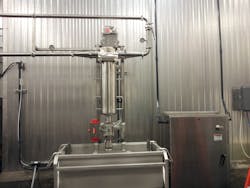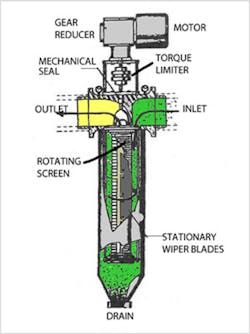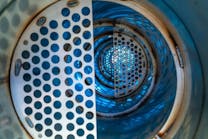Case study: Self-cleaning filter cuts downtime, improves quality for pizza sauce manufacturer
For many food manufacturers their “secret sauce” is what sets them apart from a bunch of wannabees. Consistency and quality are paramount. So when a producer of ready-to-use and concentrated pizza sauces noticed that undispersed spices were making their way into the end product, they had to find a better screening solution. Their search not only led them to a mechanical self-cleaning filtration technology that removed the unwanted spices and debris from the sauce. It also saved them downtime and increased their productivity in the process.
While their previous process, screening all sauces with a 3/8-inch perforated plate static screen, was functional, on a weekly basis they rejected one to two bins (equivalent to 300 to 600 gallons of product) because they did not meet their established quality standards. In troubleshooting ways to minimize this product loss, they discovered a build-up of undispersed spices would bridge at the static strainer screen and back up in the supply piping.
In the process, the tomato paste, water, spices and salts are combined in a tank using a high-shear mixer. Once blended, the sauce is gently pushed through a static straining system via a rotary-lobe positive displacement pump to remove agglomerated debris. The product is deposited in a large surge tank, then sterilized and directed into tanks for use. They designed the process to operate 24 hours a day, seven days a week with minimal downtime.
Static filter systems typically incorporate filter bags, cartridges, screens and other media that allow unwanted solids to rest against their surfaces, or embed between weaves, fibers or sintered metals while the product stream continues to pass through. The size of the media is generally expressed in terms of surface area or the volume of element area available to remove unwanted solids.
As these solids are removed, they decrease the volume of surface area available for the fluid to pass through. When the media have removed enough solids to affect process performance, the filter elements must be removed, disposed of or cleaned, and then reinstalled. This is generally determined by a decrease in filter outlet flow or increase in filter differential pressure.
With the rotary-lobe positive displacement pump, little decrease in flow was noticed so there was no indication of a problem. All the while, however, the pump differential pressure continued to rise, due to the loss of open screen area at the strainer. This rise in pressure can result in collapsed strainer screens and a continual increase in drive horsepower, eventually leading to drive overload. Blown holes in bags, collapsed cartridges and crushed, perforated screens are other potential problems.
The pizza sauce manufacturer's search led them to the Spencer Strainer System, a patented mechanical self-cleaning filter that continuously removes unwanted debris from its screen, keeping the filter at its "clean" differential pressure throughout the process.
The GS-144-F Spencer Strainer is installed downstream of the rotary pump. In-line inlet and outlet connections simplified the installation process, which took less than a day. As the product enters the inlet of the filter, it is directed into the filter housing where it passes through a rotating screen. This leaves unwanted debris deposited on the screen's outside diameter. Two stationary wiper blades are applied to the surface of the screen to remove the debris, which is collected in the filter housing. These particulates are periodically purged from the bottom of the filter during the process.
The strained product exits the filter and proceeds to the surge tank. By continuously removing the solids from the screen during the process, the differential pressure across the filter remains constant and the pump pressure no longer increases as the process continues.
The simplicity of the Spencer Strainer’s design, and its efficient operation, have virtually eliminated operator involvement, without the addition of auxiliary process controls. Occasionally an operator needs to open and close the flush valve to dispose of the removed solids, a simple operation that takes seconds.
With the use of the self-cleaning filter, the process is not interrupted due to pump driver overload and strainer cleaning. A cleaner product is achieved while increasing yield at the same time. The process worked so well, that they were able to use the Spencer Strainer on a hot sauce application as well, further amortizing the cost of the strainer. Payback for the technology was achieved rapidly, as the return on investment was reached in only six to eight weeks.
Paul Deaver is sales manager at Spencer Strainer.



